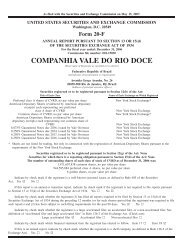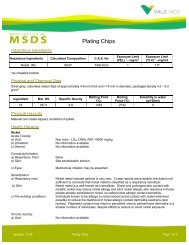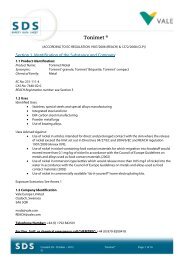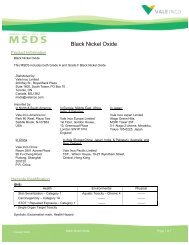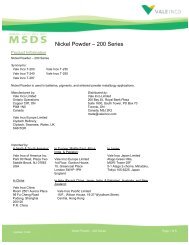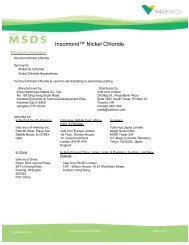PTI Nickel Matte - Vale.com
PTI Nickel Matte - Vale.com
PTI Nickel Matte - Vale.com
You also want an ePaper? Increase the reach of your titles
YUMPU automatically turns print PDFs into web optimized ePapers that Google loves.
<strong>PTI</strong> <strong>Nickel</strong> <strong>Matte</strong><br />
Product Information<br />
<strong>PTI</strong> <strong>Nickel</strong> <strong>Matte</strong><br />
<strong>PTI</strong> <strong>Matte</strong> is used for production of nickel containing materials.<br />
Manufactured by:<br />
PT International <strong>Nickel</strong> Indonesia Tbk<br />
Soroako Site<br />
South Sulawesi, 92984<br />
Indonesia<br />
Telephone: +62 411 873 732<br />
Emergency Tel: +62 21 524 9999 (Soroako Site)<br />
Distributed by:<br />
<strong>Vale</strong> Inco Limited<br />
200 Bay St., Royal Bank Plaza<br />
Suite 1600, South Tower, PO Box 70<br />
Toronto, ON<br />
Canada, M5J 2K2<br />
msds@valeinco.<strong>com</strong><br />
Imported by:<br />
<strong>Vale</strong> Inco Japan Limited<br />
Atago Green Hills,<br />
MORI Tower 25F<br />
5-1 Atago 2-chome,<br />
Minatoku,<br />
Tokyo 105-6225, Japan<br />
Hazards Identification<br />
GHS:<br />
Health Environmental Physical<br />
Skin Sensitization – Category 1 Aquatic Toxicity – Acute 1 -------<br />
Carcinogenicity – Category 1 Aquatic Toxicity – Chronic 1 -------<br />
STOT * Repeated Exposure – Category 1 ------- -------<br />
* - Single Target Organ Toxicity<br />
Symbols: Exclamation mark, Health Hazard, Environmental<br />
Signal Word: Danger<br />
Hazard Statements:<br />
May cause an allergic skin reaction.<br />
Causes damage to lungs through prolonged or repeated inhalation exposure<br />
May cause cancer by inhalation<br />
Very toxic to aquatic life with long lasting effects<br />
Created: 04/09<br />
<strong>PTI</strong> <strong>Nickel</strong> <strong>Matte</strong> Page 1 of 9
Precautionary Statements:<br />
Prevention:<br />
Obtain special instruction before use<br />
Do not handle until all safety precautions have been read and understood<br />
Use personal protective equipment as required<br />
Avoid breathing dust or fume.<br />
Contaminated work clothing should not be allowed out of the workplace.<br />
Wear protective gloves and protective clothing<br />
Wash hands, and face thoroughly after handling.<br />
Avoid release to the environment<br />
Response:<br />
If exposed or concerned: get medical advice/attention<br />
If on skin: Wash with plenty of soap and water.<br />
If skin irritation or rash occurs: Get medical advice/attention.<br />
Wash contaminated clothing before reuse<br />
See First Aid section for specific treatment information<br />
Get medical advice/attention if you feel unwell.<br />
Collect spillage<br />
Storage:<br />
Store locked up<br />
Disposal:<br />
Dispose of contents/container in accordance to local/regional/national/international regulations<br />
Composition<br />
Substance<br />
Mixture<br />
Hazardous<br />
Ingredients<br />
Typical<br />
Composition<br />
(%)<br />
C.A.S.<br />
Number<br />
<strong>Nickel</strong> subsulfide 60-80 12035-72-7<br />
<strong>Nickel</strong> cobalt iron alloy balance N/A<br />
Cobalt (II) sulfide
Wounds:<br />
Fire Fighting Measures<br />
Suitable extinguishing<br />
media:<br />
Special risks:<br />
Special protective<br />
equipment for fire fighting:<br />
Cleanse thoroughly to remove any particles.<br />
Any, type to be selected according to materials stored in the immediate area.<br />
Non-flammable. Keep containers cool with water spray.<br />
None needed. Wear protective equipment if required for other materials within the<br />
immediate vicinity.<br />
Accidental Release Measures<br />
Person related precautionary<br />
measures:<br />
Avoid generation of dusty atmospheres. Do not inhale dusts. Wear protective clothes,<br />
gloves, safety glasses, and respirator.<br />
Environmental Protection<br />
measures:<br />
Procedures for<br />
cleaning/absorption:<br />
Contain spillage. Avoid entry in sewers, and water streams.<br />
Pick up and replace in original container. <strong>Nickel</strong>-containing material is normally collected<br />
to recover nickel values.<br />
Handling and Storage<br />
Handling:<br />
Storage:<br />
Prevent the generation of inhalable dusts e.g. by the use of suitable ventilation. Do not<br />
inhale dust. Wear appropriate nationally approved respirators if handling is likely to cause<br />
the concentration limits of airborne nickel to exceed the locally prescribed exposure<br />
limits. Wear suitable protective clothing and gloves.<br />
Keep in the container supplied, and keep container closed when not in use. Store locked<br />
up. Local regulations should be followed regarding the storage of this product.<br />
Created: 04/09<br />
<strong>PTI</strong> <strong>Nickel</strong> <strong>Matte</strong> Page 3 of 9
Exposure Controls / Personal Protection<br />
<strong>Nickel</strong> Subsulfide – CAS 12035-72-7<br />
Exposure Limit<br />
ACGIH TLV-TWA 1<br />
0.1 mg/m 3 * (as Ni)<br />
UK WEL 2<br />
0.5 mg/m 3 (as Ni)<br />
Japan<br />
1 mg/m 3 (as Ni)<br />
Korea<br />
2 mg/m 3 (as Ni)<br />
Indonesia<br />
1 ppm<br />
* - in inhalable fraction<br />
Cobalt (II) sulfide – CAS 1317-42-6<br />
Exposure Limit<br />
ACGIH TLV-TWA 1<br />
0.02 mg/m 3 (as Co)<br />
UK WEL 2<br />
0.1 mg/m 3 (as Co)<br />
Japan<br />
0.05 mg/m 3 (as Co)<br />
Korea<br />
0.05 mg/m 3 (as Co)<br />
Maintain airborne levels as low as possible.<br />
Occupational exposure controls:<br />
a. Respiratory protection: Ventilation may be required if user operations change it to other physical or chemical<br />
forms, whether as end products, intermediates or fugitive emissions, which are<br />
inhalable.<br />
b. Eye protection: None<br />
c. Hand & Skin Protection: Avoid repeated skin contact. Wear suitable protective clothing and gloves, which should<br />
be selected specifically for the working place, depending on concentration and quantity<br />
of the hazardous material (overalls and leather/rubber gloves). Wash skin thoroughly<br />
after handling and before eating, drinking or smoking. Change contaminated clothing<br />
frequently. Launder clothing and gloves as needed. Use of skin-protective barrier cream<br />
advised.<br />
Physical and Chemical Properties<br />
Black-grey colored granules; insoluble in water<br />
Created: 04/09<br />
<strong>PTI</strong> <strong>Nickel</strong> <strong>Matte</strong> Page 4 of 9
pH<br />
Not Applicable (N/A)<br />
Boiling point/ boiling range 2582°C<br />
Melting point 540°C<br />
Flash Point<br />
N/A<br />
Evaporation rate<br />
N/A<br />
Vapor Temperature 2857°C<br />
Flammability<br />
N/A<br />
Explosive properties<br />
Not explosive<br />
Vapor pressure<br />
N/A<br />
Vapor density<br />
N/A<br />
Relative density<br />
No data<br />
Solubility cold water<br />
Insoluble<br />
Solubility hot water<br />
Insoluble<br />
Partition coefficient<br />
N/A<br />
Auto-ignition temperature N/A<br />
De<strong>com</strong>position temperature N/A<br />
Oxidizing properties<br />
Not oxidizing<br />
Viscosity<br />
N/A<br />
Packaged Density 3.8 g/cm 3<br />
Loose Density 3.3 g/cm 3<br />
Particle size<br />
70% 0.15 mm – 0.8 mm<br />
Max. 10% >0.8 mm<br />
Max. 20% 5000 mg/kg<br />
Created: 04/09<br />
<strong>PTI</strong> <strong>Nickel</strong> <strong>Matte</strong> Page 5 of 9
Inhalation:<br />
The National Toxicology Program has listed nickel subsulfide as reasonably anticipated to be a<br />
carcinogen based on the production of injection-site tumors. The International Agency for Research<br />
on Cancer (IARC) concluded there was sufficient evidence that nickel <strong>com</strong>pounds are carcinogenic<br />
to humans and that crystalline nickel sulfides are carcinogenic to animals. Epidemiological studies<br />
of workers engaged in the oxidation of nickel subsulfide (Ni 3 S 2 ) by dusty processes indicated the<br />
presence of a significant respiratory cancer hazard.<br />
The American Conference of Governmental Industrial Hygienists (ACGIH) have classified nickel<br />
subsulfide as a Confirmed Human Carcinogen; category A1.<br />
Rats exposed by inhalation to ~1 mg Ni 3 S 2 /m 3 experienced an increased incidence of malignant<br />
lung tumors. Repeated intratracheal instillation of nickel subsulfide produced an increased<br />
incidence of malignant lung tumors in rats. Repeated intratracheal instillation of nickel subsulfide<br />
did not produce an increased incidence of malignant lung tumors in hamsters when administered at<br />
the maximum tolerated dose.<br />
Wounds:<br />
Ingestion:<br />
<strong>Nickel</strong> subsulfide is a potent experimental carcinogen in rodents by parenteral routes of<br />
administration.<br />
The U.S. National Institute for Occupational Safety and Health (NIOSH) concluded there is no<br />
evidence that nickel and its inorganic <strong>com</strong>pounds are carcinogenic when ingested.<br />
<strong>Nickel</strong> cobalt iron alloy<br />
A literature search found no toxicological information for <strong>Nickel</strong> cobalt iron alloy. Toxicology information is provided for its<br />
main constituents; nickel, cobalt, and iron.<br />
<strong>Nickel</strong><br />
Acute Toxicity:<br />
a) Oral: Non toxic - LD50 ORAL RAT >9000 mg/kg<br />
b) Inhalation: No information available<br />
c) Dermal: No information available.<br />
Corrosivity/Irritation:<br />
a) Respiratory Tract: None<br />
b) Skin: See sensitization section.<br />
c) Eyes: Mechanical irritation may be expected.<br />
Sensitization:<br />
a) Respiratory tract: <strong>Nickel</strong> metal induced asthma is very rare. 3 case reports are available; the data is not<br />
sufficient to conclude that nickel metal is classified as a respiratory sensitizer.<br />
b) Skin: <strong>Nickel</strong> metal is a well-known skin sensitizer. Direct and prolonged skin contact with<br />
metallic nickel may induce nickel allergy and elicit nickel allergic skin reactions in those<br />
people already sensitized to nickel, so called nickel allergic contact dermatitis.<br />
c) Pre-existing conditions: Individuals known to be allergic to nickel should avoid contact with nickel whenever<br />
possible to reduce the likelihood of nickel allergic contact dermatitis reactions (skin<br />
Created: 04/09<br />
<strong>PTI</strong> <strong>Nickel</strong> <strong>Matte</strong> Page 6 of 9
ashes). Repeated contact may result in persistent chronic palmar/hand dermatitis in a<br />
smaller number of individuals, despite efforts to reduce or avoid nickel exposure.<br />
Chronic toxicity:<br />
a) Oral: No information available<br />
b) Inhalation: Animal studies (rats) show that repeated dose inhalation of nickel damages the lung.<br />
Chronic inflammation, lung fibrosis and accumulation of nickel particles were observed.<br />
c) Dermal: Direct and prolonged skin contact with nickel metal may cause nickel sensitization<br />
resulting in nickel allergic contact dermatitis /skin rash.<br />
Mutagenicity /<br />
Reproductive toxicity:<br />
No data.<br />
Carcinogenicity:<br />
a) Ingestion: The U.S. National Institute for Occupational Safety and Health (NIOSH) concluded that<br />
there is no evidence that nickel metal is carcinogenic when ingested.<br />
b) Inhalation: There is limited information available from inhalation and intratracheal studies in animals.<br />
The U.S. National Toxicology Program has listed metallic nickel as reasonably<br />
anticipated to be a human carcinogen. To date, there is no evidence that nickel metal<br />
causes cancer in humans based on epidemiology data from workers in the nickel<br />
producing and nickel consuming industries.<br />
Cobalt<br />
LD50 oral rat: 6171 mg/kg<br />
The International Agency for Research on Cancer (IARC)(Vol 49) found there was inadequate evidence that<br />
metallic nickel is carcinogenic to humans but since there was sufficient evidence that it is carcinogenic to<br />
animals, IARC concluded that metallic nickel is possibly carcinogenic to humans (Group 2B). In 1997, the<br />
ACGIH categorized elemental nickel as: A5 "Not Suspected as a Human Carcinogen". Epidemiological<br />
studies of workers exposed to nickel powder and to dust and fume generated in the production of nickel<br />
alloys and of stainless steel have not indicated the presence of a significant respiratory cancer hazard<br />
Inhalation:<br />
Skin Contact:<br />
Asthmatic symptoms and pulmonary fibrosis occurring in the tungsten carbide industry<br />
may be related to the inhalation of metallic cobalt dust. Evidence of polycythemia (an<br />
increase in the total red cell mass of the blood in the body) and altered thyroid, kidney<br />
and liver function have also been found. Excessive doses of metallic cobalt have<br />
produced cardiac changes in miniature swine.<br />
Repeated contact with metallic cobalt can cause cobalt sensitivity and allergic skin<br />
rashes.<br />
Wounds:<br />
Pre-existing Conditions:<br />
Cobalt powders have caused tumors at the site of injection in rodents. However, studies<br />
of cobalt containing prostheses do not suggest a significant risk for humans.<br />
Sensitized individuals may experience an allergic skin rash or asthma.<br />
Iron<br />
Created: 04/09<br />
<strong>PTI</strong> <strong>Nickel</strong> <strong>Matte</strong> Page 7 of 9
LD50 oral rat: 30,000 mg/kg<br />
Prolonged eye contact with the metal dust could cause rust-brown coloured spots forming around the particles and if left<br />
for several years, permanent damage could result.<br />
Cobalt (II) Sulfide<br />
Oral LD50 >5000 mg/kg<br />
A literature search found no toxicological information for cobalt sulphide. Toxicology is expected to be similar to cobalt<br />
oxide.<br />
Cobalt Oxide<br />
Inhalation:<br />
Some workers engaged long-term in the production of cobalt oxides showed symptoms of<br />
chronic bronchitis. Inhalation experiments show that cobalt oxide accumulated in the lymph<br />
nodes of dogs suggesting it is tissue insoluble.<br />
Ecological Information<br />
Very toxic to aquatic organisms may cause long-term adverse effects in the aquatic environment. Do not discharge into<br />
sewer or waterways.<br />
Disposal Considerations<br />
<strong>Nickel</strong>-containing material is normally collected to recover nickel values. Should disposal be deemed necessary, follow<br />
local regulations.<br />
Created: 04/09<br />
<strong>PTI</strong> <strong>Nickel</strong> <strong>Matte</strong> Page 8 of 9
Transport Information<br />
International Maritime Dangerous Goods<br />
Code<br />
International Civil Aviation Organization<br />
Technical Instructions for the Carriage of<br />
Dangerous Goods by Air<br />
U.S. Dept. of Transportation Regulations<br />
Canadian Transportation of Dangerous<br />
Goods Act<br />
European Agreement Concerning the<br />
International Carriage of Dangerous Goods<br />
by Road<br />
Not regulated.<br />
After January 1, 2010 this material will be considered<br />
a Dangerous Good for Transport. The proper<br />
shipping name will be:<br />
UN3077, Environmentally Hazardous Substance,<br />
Solid, NOS (<strong>Nickel</strong> powder), class 9, PG III<br />
Not regulated.<br />
Not regulated.<br />
Not regulated.<br />
Not regulated.<br />
After July 1, 2009 this material will be considered a<br />
Dangerous Good for Transport. The proper shipping<br />
name will be:<br />
UN3077, Environmentally Hazardous Substance,<br />
Solid, NOS (<strong>Nickel</strong> powder), class 9, PG III<br />
Regulatory Information<br />
Other Information<br />
Safety Data Sheet prepared by:<br />
<strong>Vale</strong> Inco Limited<br />
200 Bay St., Royal Bank Plaza<br />
Suite 1600, South Tower, PO Box 70<br />
Toronto, ON<br />
Canada, M5J 2K2<br />
Product Stewardship (416) 361-7801<br />
msds@valeinco.<strong>com</strong><br />
SDS available online at www.valeinco.<strong>com</strong><br />
Note:<br />
<strong>Vale</strong> Inco believes that the information in this Material Safety Data Sheet is accurate. However, <strong>Vale</strong> Inco makes no express or<br />
implied warranty as to the accuracy of such information and expressly disclaims any liability resulting from reliance on such<br />
information.<br />
1. Threshold Limit Values of the American Conference of Governmental Industrial Hygienists. 2008.<br />
2. Maximum Exposure Limit of the Health and Safety Executive in the U.K. in EH40/00.<br />
Created: 04/09<br />
<strong>PTI</strong> <strong>Nickel</strong> <strong>Matte</strong> Page 9 of 9



